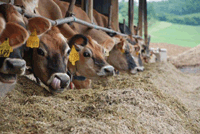Knowledge is power and starch testing provides insight that could save your farm money.
 Running out of feed is never a desirable situation, but as harvest gets underway it's not unlikely for feed inventories to start to dwindle. If inventories do run low, you may be forced to purchase additional feed ingredients.
Running out of feed is never a desirable situation, but as harvest gets underway it's not unlikely for feed inventories to start to dwindle. If inventories do run low, you may be forced to purchase additional feed ingredients. To ease the purchase of feed ingredients, Kevin Leahy, nutritionist and technical services manager with Calibrate® Technologies suggests dairymen look to rumen degradable starch testing. The insights garnered from rumen degradable starch testing could potentially save money when it comes to purchasing feed. "You can also make a more informed purchase," he says.
 For example, if purchasing corn, money might not need to be spent for processing because the feed ingredients remaining in inventory on-farm have a highly rumen degradable starch level. Eliminating processing like flaking or rolling could result in financial savings. Leahy notes that flaking increases the moisture content of the corn and you often end up paying for more water.
For example, if purchasing corn, money might not need to be spent for processing because the feed ingredients remaining in inventory on-farm have a highly rumen degradable starch level. Eliminating processing like flaking or rolling could result in financial savings. Leahy notes that flaking increases the moisture content of the corn and you often end up paying for more water.Knowing the rumen degradable starch content might also provide the opportunity to look at a byproduct ingredient that offers starch. This can open the door to including more cost-saving byproduct ingredients in the ration. Insight on the rumen degradable starch content could allow for greater use of ingredients like hominy, corn gluten feed, bakery byproducts and corn flour, replacing the need for purchasing corn grain. "The use of byproduct feeds could potentially lower purchased feed cost," says Leahy.
Information from a rumen degradable starch test can also help with inventory management. Case in point, if a dairy producer measures the remaining inventory in his silage bunker and determines he must decrease the amount of silage fed per day by 4 pounds of dry matter for the remainder of the year, to avoid running out of corn silage, a rumen degradable starch test can help.
Leahy explains, "If the dairymen's nutritionist runs a rumen degradable starch test on the corn silage and learns that the ruminal degradability of that starch is high, they can use that information when determining what type of byproduct ingredients could be used to replace the starch provided by those 4 pounds of corn silage. The nutritionist may find that starch containing ingredients with lower ruminal starch degradability, and likely lower processing costs, will work to provide the optimum amount of rumen degradable starch in the ration; maintaining production while decreasing ration cost."
Regardless of the situation, knowledge gained from rumen degradable starch tests can provide information that could save money.
For more information on ruminal starch digestibility contact Kevin Leahy by at (636) 742-6275, email: KTLeahy@calibratetechnologies.com
Calibrate® technology provides one of the dairy industry's first rapid starch test with ration recommendations to nutritionists and producers on rumen digestibility of forages and feedstuffs. For additional information, visit www.CalibrateTechnologies.com
07.17.2012